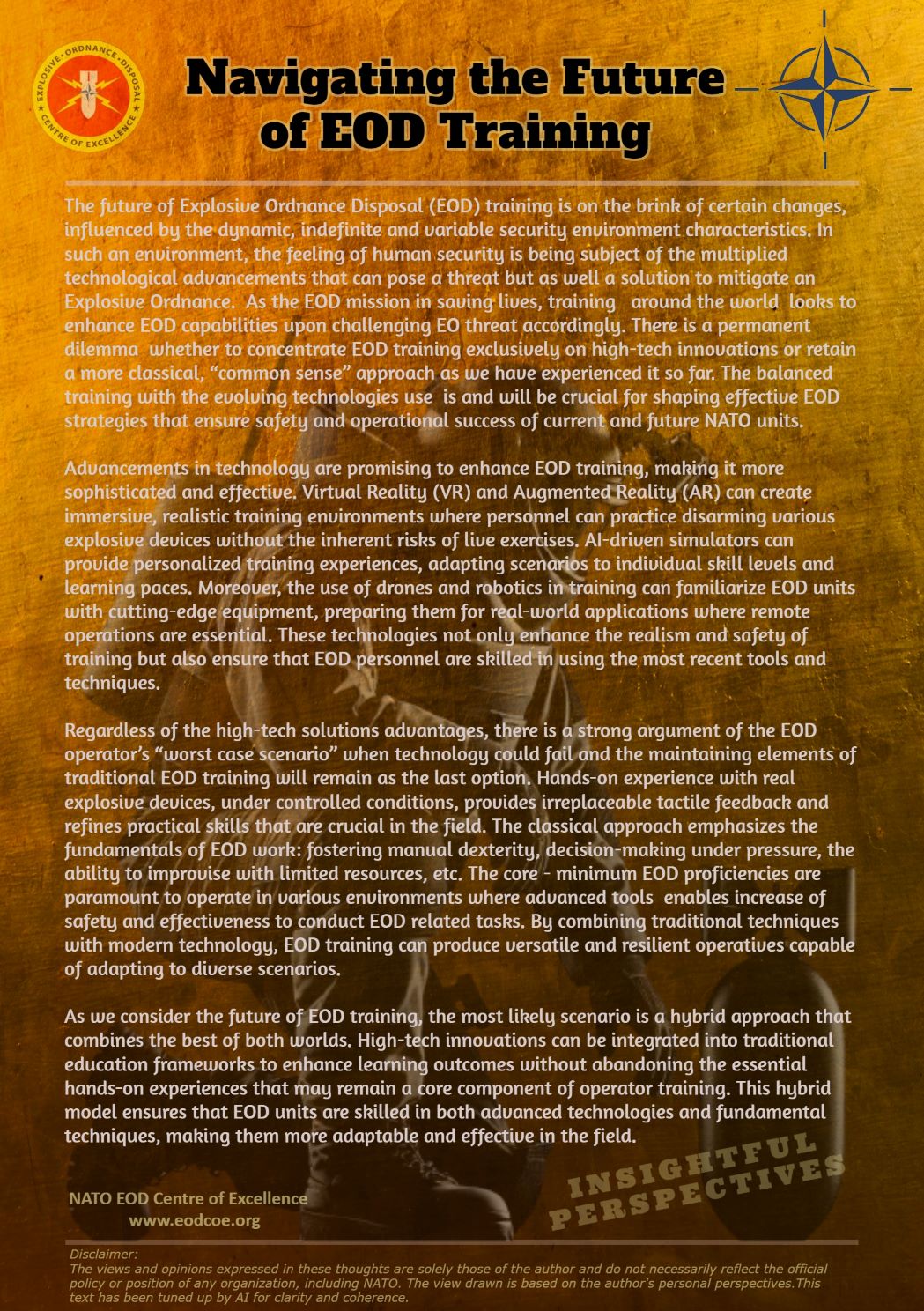
Navigating the Future of EOD Training
The future of Explosive Ordnance Disposal (EOD) training is on the verge of certain changes, influenced by the dynamic, indefinite and variable security environment characteristics. In such an environment, the feeling of human security is being subject of the multiplied technological advancements that can pose a threat but as well a solution to mitigate an Explosive Ordnance. Since the goal of EOD is to save lives, training programs all over the world strive to improve EOD capabilities when confronting EO threats.
There is a permanent dilemma whether to concentrate EOD training exclusively on high-tech innovations or retain a more classical, “common sense” approach as we have experienced it so far. The balanced training with the evolving technologies use is and will be crucial for shaping effective EOD strategies that ensure safety and operational success of current and future NATO units.
Advancements in technology are revolutionizing EOD training, making it more sophisticated and effective. Modern innovative methods, such as human-machine integration, are transforming the training environment by enhancing both individual and team capabilities. Virtual Reality (VR) and Augmented Reality (AR) create immersive, realistic training scenarios where personnel can safely practice disarming various explosive devices without the inherent risks of live exercises. AI-driven simulators offer personalized, adaptive experiences tailored to individual skill levels and learning paces.
Furthermore, integrating human operators with robotics, drones, and autonomous systems not only familiarizes EOD units with cutting-edge equipment but also enhances their operational synergy, enabling them to execute remote operations with precision. These technologies not only elevate the realism and safety of training but also ensure that EOD personnel are proficient in using the latest tools and approaches while optimizing human-machine collaboration for future challenges.
Notwithstanding the benefits of high-tech solutions, there is a compelling case to be made for the "worst case scenario" of the EOD operator, in which technology malfunctions and traditional EOD training components are left as a last resort. Hands-on experience with real explosive devices, under controlled conditions, provides irreplaceable tangible feedback and refines practical skills that are crucial in the field. The classical approach emphasizes the fundamentals of EOD work: fostering manual dexterity, decision-making under pressure, the ability to improvise with limited resources, etc. The core - minimum EOD proficiencies are paramount to operate in various environments where advanced tools enables increase of safety and effectiveness to conduct EOD related tasks. By combining traditional techniques with modern technology, EOD training can produce versatile and resilient operatives capable of adapting to diverse scenarios.
As we consider the future of EOD training, the most likely scenario is a hybrid approach that combines the best of both worlds. High-tech innovations can be integrated into traditional education frameworks to enhance learning outcomes without abandoning the essential hands-on experiences that may remain a core component of operator training. However, the question of proportionality between the application of advanced technologies and the continued emphasis on fundamental techniques is a critical consideration.
Setting the right equilibrium between advanced technology and fundamental techniques in training is essential. Over-reliance on technology could undermine the development of instinctive, manual problem-solving skills, while excessive focus on basic methods may leave personnel unprepared for increasingly tech-driven missions. A well-structured hybrid model, tailored to the circumstances and capabilities, ensures that EOD units are proficient in both advanced technologies and core techniques. This approach equips them to adapt to a wide range of scenarios while maintaining operational effectiveness. By thoughtfully blending these approaches, EOD training can maximize both adaptability and proficiency in real-world environments.